The History of the Pratley
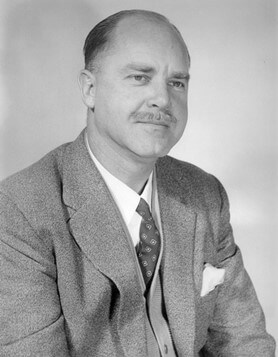 The founder of the Pratley, George Montague Pratley, or "Monty", was born in Johannesburg on 19 September 1917 and educated at King Edward School and Wits University. After the death of his father, he used a small inheritance to study at Rugby College of Technology and Arts in England.
The founder of the Pratley, George Montague Pratley, or "Monty", was born in Johannesburg on 19 September 1917 and educated at King Edward School and Wits University. After the death of his father, he used a small inheritance to study at Rugby College of Technology and Arts in England.
When war was declared in 1939 he intended to join the British Army, but as he was employed by the British Thomson Houston Company of Whittle Jet Engine fame, an essential industry as far as the war effort was concerned, this company would not release him. He was eventually released in 1942 and joined the 7th Armoured Division in time to take part in the D-Day landings in Normandy.
After the war had ended, he was repatriated to South Africa in 1946 and was employed for two years at the Durban Deep Gold Mine on the Reef before starting his own business.
The Pratley Manufacturing and Engineering Company was launched in 1948 in a rented garage in Hillbrow - the company's main focus being jobbing work for both large and very small mines. With a capital of 349 Pounds, G.M. Pratley purchased a few items of both new and second hand equipment, and with the help of Sam Matlebe, his first employee, he carried out repairs on mine pumps and made fittings and valves for the mining industry. Donald Cock joined Pratley shortly after Sam, as the first journeyman. He had worked with Monty on the gold mines and remained with Pratley for 42 years.
The first Pratley trading location was situated in Roodepoort on the F.C. Holton business premises, and consisted of a workshop with an adjoining 2 bedroomed flat which had a kitchen, lounge and bathroom. The bedrooms, with one window overlooking the workshop, were used as offices. The workshop was developed from very humble beginnings and consisted of a small lathe, a very small milling machine, a reasonably sized shaping machine, two drilling machines and a medium sized saw.
During the early years, Monty's mother, Olive, and his wife, Marguerite, also played an important role in the company, especially with accounts and administration.
The machines in the first workshop were adequate, but very often just too small, for some of the "jobbing" work, so "head scratching", together with loads of initiative, were the order of the day. Some of the mine jobs were rather intricate and were often rejected by other engineering firms, but with much hard work and optimism the company succeeded in satisfying its customers. It was not long before Monty created a good name for himself by turning out quality products. Being a perfectionist and an innovative genius, Monty never reproduced any item without redesigning or improving it. Spare parts were made for all the local stone crushing plants and for many other industrial concerns. The company even reconditioned bottling machines for soft drinks.
Besides the jobbing work, the company imported reconditioned "Fordson" tractors from the U.K to be sold to local farmers. Pratley Engineering also had the agency for "Tungsten Carbide Tip Lapping and Honing Tools", emery wheel dressers and Pratley Hand Cleaner. Other items that were made included precision pump screws; Burglar alarm switches; Rubber toys (racing cars, tractors and saloon cars) and a special design of rubber bath plug.
A huge "Drop Hammer" was built in 1952 for the manufacture of "Crosby Clamps" for clamping electrical conductors. Other special-purpose machines had to be designed and made for making "U" bolts for the Crosby Clamps - shearing, straightening and bending machines.
The reconditioning of water pumps for the mines became a difficult but lucrative business, and was probably responsible for the greater part of the early success of the company. So, in 1955, Monty used capital, and some money which he borrowed from his mother, to purchase a building site in Factoria, Luipaardsvlei, on which a factory and main offices were erected and are presently situated. The first buildings on the new premises consisted of 2 identical red brick workshops, complete with 1 office, 1 toilet and 2 change rooms. Soon, the larger workshops were filled with new equipment, which was made possible by the steadily increasing success of the business.

Pratley Head Office & Manufacturing Facility - Krugersdorp, South Africa
Pump reconditioning continued well into the 1960's, but the designing and production of a first class cable gland in 1959/1960, revolutionary in quite a few aspects, really made the company a force to be reckoned with. This development was made possible due to one of the other products being manufactured at the time: a remote-controlled blasting unit which threatened the existence of the delay fuse industry. The patent for the blasting unit was purchased by a company wanting to protect its interest, it was withdrawn from the market and the proceeds from the sale not only allowed Monty to repay his mother's loan, but to mass-produce his patented adjustable cable glands.
A well-equipped laboratory and a printing department were established at the Krugersdorp factory to achieve self-sufficiency. Rubber formulations were milled on site and 3 different designs of Flameproof Cable Gland and 5 sizes of cast iron cable junction boxes were also manufactured. These junction boxes were used by the Krugersdorp municipality - for electrical reticulation purposes - and also by many other municipalities, mines and general industry.
Around 1959/1960, an aluminium foundry was designed, built and put into operation. This foundry was designed specifically for the production of aluminium alloy cable junction boxes, roof connector boxes - for facilitating the rewiring of old houses - and underground lighting boxes, which were fitted to long lengths of cable, rolled onto a cable drum or "spool", taken underground and then rolled off the drum where required and strung up as a ready-made lighting system. Pratley Aluminium Alloy Foundation Boxes played a significant role in keeping the cost of low-cost housing down to a minimum, by providing an inexpensive means of connecting the incoming reticulation cable with the in-house wiring.
A number of other products were also developed, but never really got off the ground. These included: hydraulic car stackers for parking garages; Latco valve type hot water regulators; battery and electrical lawn mowers; borehole pumps and door closers.
Monty was instrumental in encouraging and formulating a suitable specification for flameproof glands as used in the South African environment and, whilst serving on the flameproof committee, rendered invaluable service in the birth of a South African specification: SABS 808/1967 for Flameproof Glands. With the assistance of other members of the staff of Pratley Engineering, Mr. G.M. Pratley also assisted in preparing, advising and recommending the compilation of what would become SABS 1213: 1984 - the specification for Mechanical Cable Glands suitable for wire armoured and unarmoured cables.
Donald Cock became the world's expert on cable gland design and Sam Matlebe - the company's first employee - proved what a unique person he was. As the company expanded and employed more staff, his advice was sought by both black and white employees in respect of both business and personal problems - at a time when apartheid was at its peak. Sam had a gift for defusing any volatile situations. Monty's mother, Olive, played an important role in the company by looking after accounts and his wife, Marguerite, excelled herself while handling the administration and the processing of the many patents involved. This was at a time that she had two small children to rear and the family was living under difficult conditions in some outbuildings in Krugersdorp.
Pratley Putty - then known as Pratley Plastic Putty - was developed in the Pratley laboratory in the early sixties, and eventually put the Pratley name on the world map. The product was developed as an insulator and also as an adhesive agent for fixing brass terminals which were located inside the cast iron cable junction boxes. As time went by, many other uses were found for the putty, which enabled it to penetrate both the consumer and the industrial and mining markets. The mouldable putty was converted to a gluey paste with a greater adhesive strength and these products were soon being manufactured under licence in America and New Zealand.
An article appeared in a Johannesburg newspaper which sketched the initial story of epoxy resins:
...the age of nuts and bolts and ordinary adhesives is fast giving way to the space-age era of epoxy adhesives. A Krugersdorp company has led the world in this scientific advance. Epoxy resins are making conventional means of securing and repairing seem crude and inadequate. Their unlimited versatility for permanently bonding, repairing, filling and scaling is hailed as fantastic progress."Pratley Putty was the first of its type in the world and had the distinction of being used on one of the American space modules to land on the moon. Pratley Putty was also used in a repair of the Golden Gate Bridge spanning the San Francisco Bay, and in South Africa the holes in two sunken ships were repaired with the adhesive, which sets under water. Both ships were raised and ultimately sailed the high seas once more.
 Pratley Putty was the first of its type in the world and had the distinction of being used on one of the American space modules to land on the moon. Pratley Putty was also used in a repair of the Golden Gate Bridge spanning the San Francisco Bay, and in South Africa the holes in two sunken ships were repaired with the adhesive, which sets under water. Both ships were raised and ultimately sailed the high seas once more.
Pratley Putty was the first of its type in the world and had the distinction of being used on one of the American space modules to land on the moon. Pratley Putty was also used in a repair of the Golden Gate Bridge spanning the San Francisco Bay, and in South Africa the holes in two sunken ships were repaired with the adhesive, which sets under water. Both ships were raised and ultimately sailed the high seas once more.
Mr. G.M. Pratley took many decisions which improved the credibility of his business, one of them being the adoption of a constructive marketing strategy from the early days and the appointment of Mr. "Mac" Coen as the company's first Marketing Director.
In 1972, the Ezee-fit range of cable junction boxes proved to be an immediate success and thousands of them were installed in SASOL petroleum plants.
In 1974, a Perlite processing factory was built in Chamdor. This was necessary because Monty had been prospecting for perlite in Zululand for many years, and hundreds of holes were drilled using Pratley equipment. The perlite factory, representing millions of Rand of investment, included a railway siding as well.
The staff, by 1974, had swelled from the original 3 to over 300. Pratley Engineering had assisted many immigrants in coming to South Africa between 1967 and 1975 (many came from a company called "Marconi's" in England) by employing them and arranging accommodation near to the factory. Two houses were bought for this purpose, acting as stepping stones to acquiring their own accommodation.
Beautifully equipped laboratories ensured that the highest degree of technology in the adhesive field was not only maintained, but in many respects enhanced, by a few world firsts such as Pratley Putty and Pratley Wondafix.
Most of the Pratley sales and marketing literature, as well as instruction leaflets for the many
Pratley products, were (and still are) produced in-house in the printing department. The various
rubber formulations required for hundreds of sizes of compression bushes and waterproofing shrouds
for cable glands and boxes were (and still are) milled on site and then moulded. Plastic injection
moulding machines churned out thousands upon thousands of plastic cable glands, skid washers, gaskets and locknuts.
In May 1983, the Pratley Group was deeply saddened by the untimely death of their popular and
much-respected founder and Managing Director. His son Kim, who joined the company in 1979 after
graduating from Wits University as a Mechanical Engineer, took over the company. K.G.M. Pratley was well-schooled by his father for this position and,
since 1983, has controlled the company's affairs with great dedication and efficiency. He was married
to Valerie and they had two sons, Andrew and Charles.
In 1985, Kim Pratley launched another world-first into the market - Pratley Wondafix: a unique
adhesive, in that it displays both superior adhesive strength and remarkable flexibility. On
this occasion, he stood underneath a bulldozer that had been lifted using Wondafix, confident
that the vehicle would not fall on him.
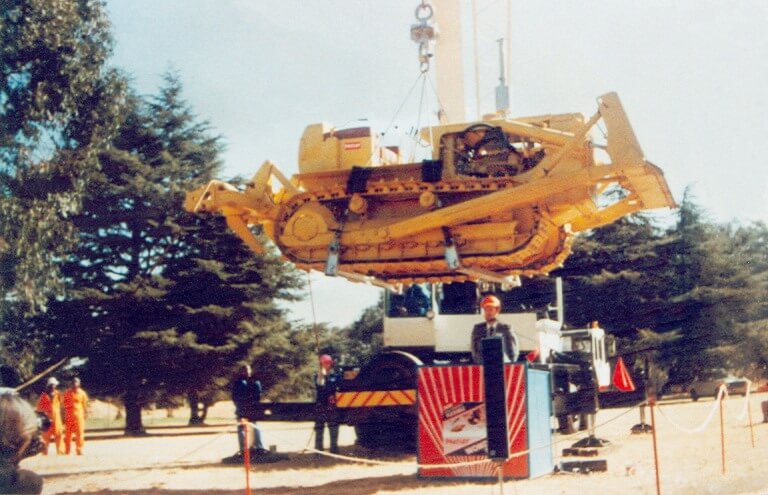
Pratley CEO, Kim Pratley addresses the media while
standing underneath a 13 tonne bulldozer
suspended in the air by a Pratley Wondafix adhesive joint.
By 1988, a product which is no longer being marketed by the group - Tik-Tak- was being
milled and packaged in-house.
All epoxy products were being formulated, mixed and packaged in the Polymers factory,
before being despatched from the well organised stores.
Well-equipped laboratories, with the aid of sophisticated spectrophotometers and
computers could identify almost any known mineral and could crack most formulae
used in the adhesive field. Research and development of new products, both chemical
and mechanical, had become an ongoing activity at Pratley.
Tufflon light duty glands were being injection moulded in the moulding shop.
Drawing and design work was being done in the drawing office, which also served the
well equipped tool room and production shops.
By the beginning of the 1990's, this second-generation family business was more of a
success than ever before. 1993 saw the launch of the world's fastest setting adhesive -
Pratley Wham. Most people who witnessed the product launch will never forget the
demonstration when a crane lifted a Volkswagen Beetle by a hook attached to a plate
which had been fixed by the adhesive to the roof of the vehicle approximately five
seconds before. This product was eventually taken off the market, because it simply
worked to fast for most people to handle!
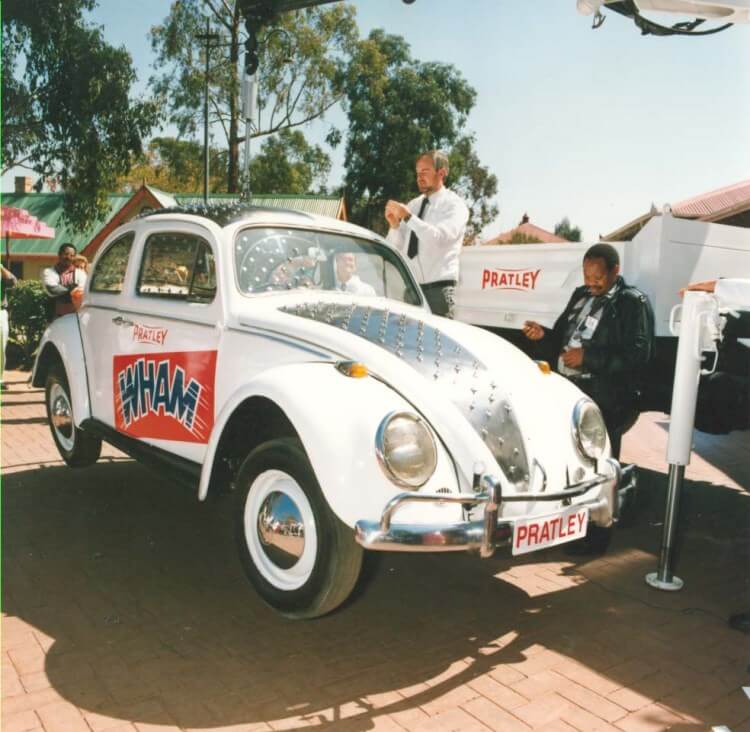
At the launch of Pratley Wham, CEO Kim
Pratley successfully lifts a VW Beetle into the air 5 seconds
after applying Pratley Wham adhesive to the joint.
The late 1990's and forward into the new century, saw the Pratley Group growing
from strength to strength. In 2005, Kim Pratley's son Andrew joined the company
after completing a degree in Information Technology. After completing a industrial
engineering degree in 2009 his youngest son, Charles also joined.
Many of the group's achievements, are due in no small part to the efforts of the
company's founder, Mr. G.M. Pratley: a founder industrialist, man of vision, optimist,
mentor of all who served under him, leaving none uninfluenced by his philosophy.
"One of my father's most unique attributes was his total belief in
his ability to succeed. Failure was not in his vocabulary. I think some of his
success can be ascribed to the fact that he dealt entirely in the realm of
reality. In business he considered only facts - everything else, with the exception
of entrepreneurial gut feel, was rejected. Certainly, a great deal of his success
was the result of his ability to draw a very distinct line between the right way
and the wrong way , moral behaviour and amoral behaviour, good and bad, right and
wrong. In short, there was no grey area in his thought process. I am convinced
that this simplified his life and allowed him to focus on goals. His ethics were
at all times beyond question. He was a tough businessman, but was also proud of
his unblemished reputation for ethical business practice. He abhorred bribery,
corruption and underhand business dealings."
In later years, he resisted approaches by large companies to buy him out, as well as the temptation
to go public. This would have made him immensely wealthy, but would have deprived him of his
independence and his freedom to pursue innovative ideas. He found all new technologies
exciting and was always eager to implement them.
"His hands-on attention-to-detail style of management, the development of
an intense company culture, the decision to equip a research laboratory to the highest
technical standard in order to become self-sufficient in terms of manufacturing
capability and in ancillary areas of the business, and last but not least, his
ongoing pursuit of innovative and superior performance products, contributed to
the hallmarks of our business strategy today."
In January 2021, Pratley was once again deeply saddened by the untimely passing of their respected Managing Director, Kim Pratley. Pratley is now capably run and managed by the late Kim Pratley’s sons, Andrew and Charles Pratley who were well mentored by their father. Both have worked at Pratley since 2005 and 2009, respectively.





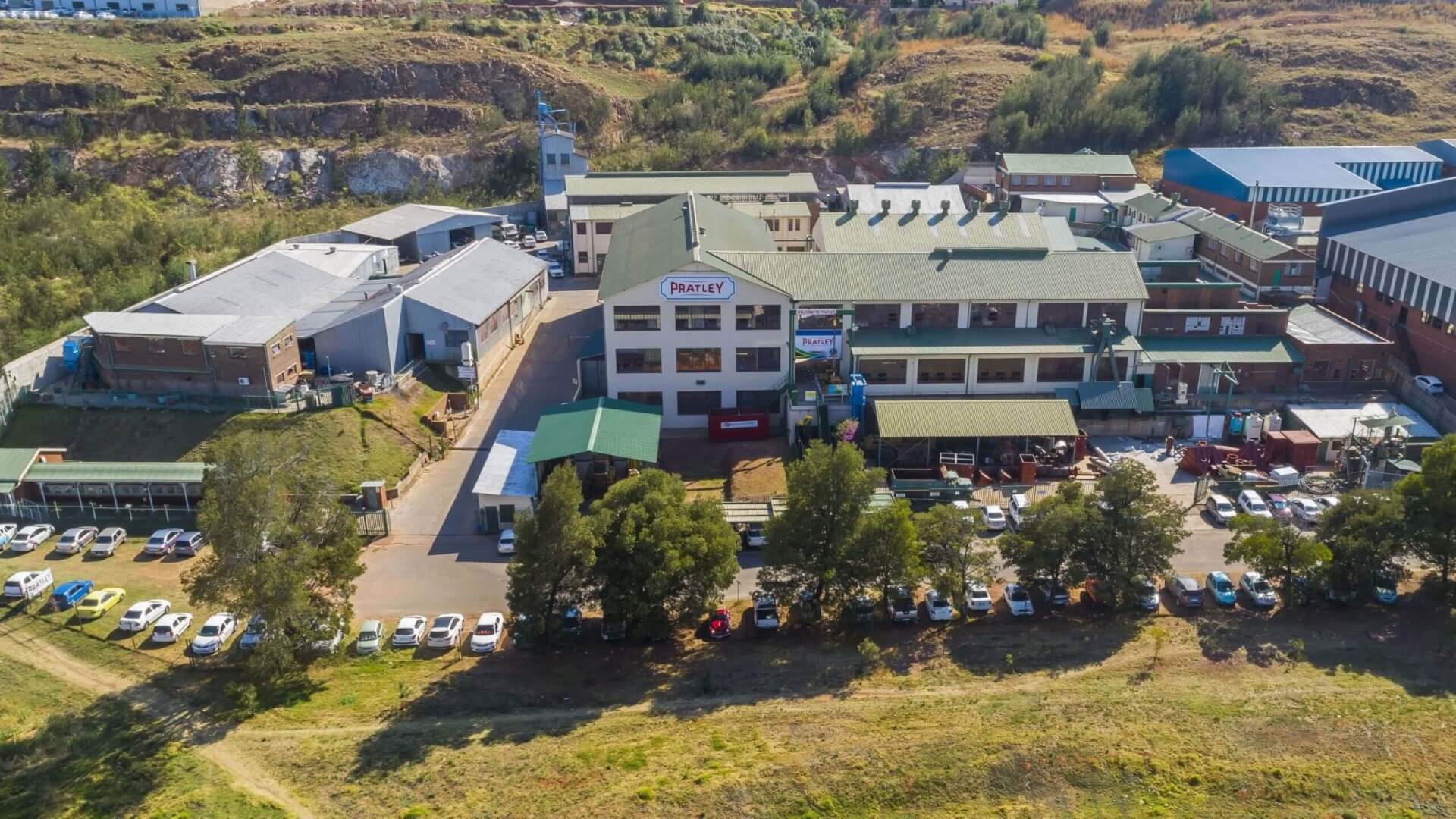






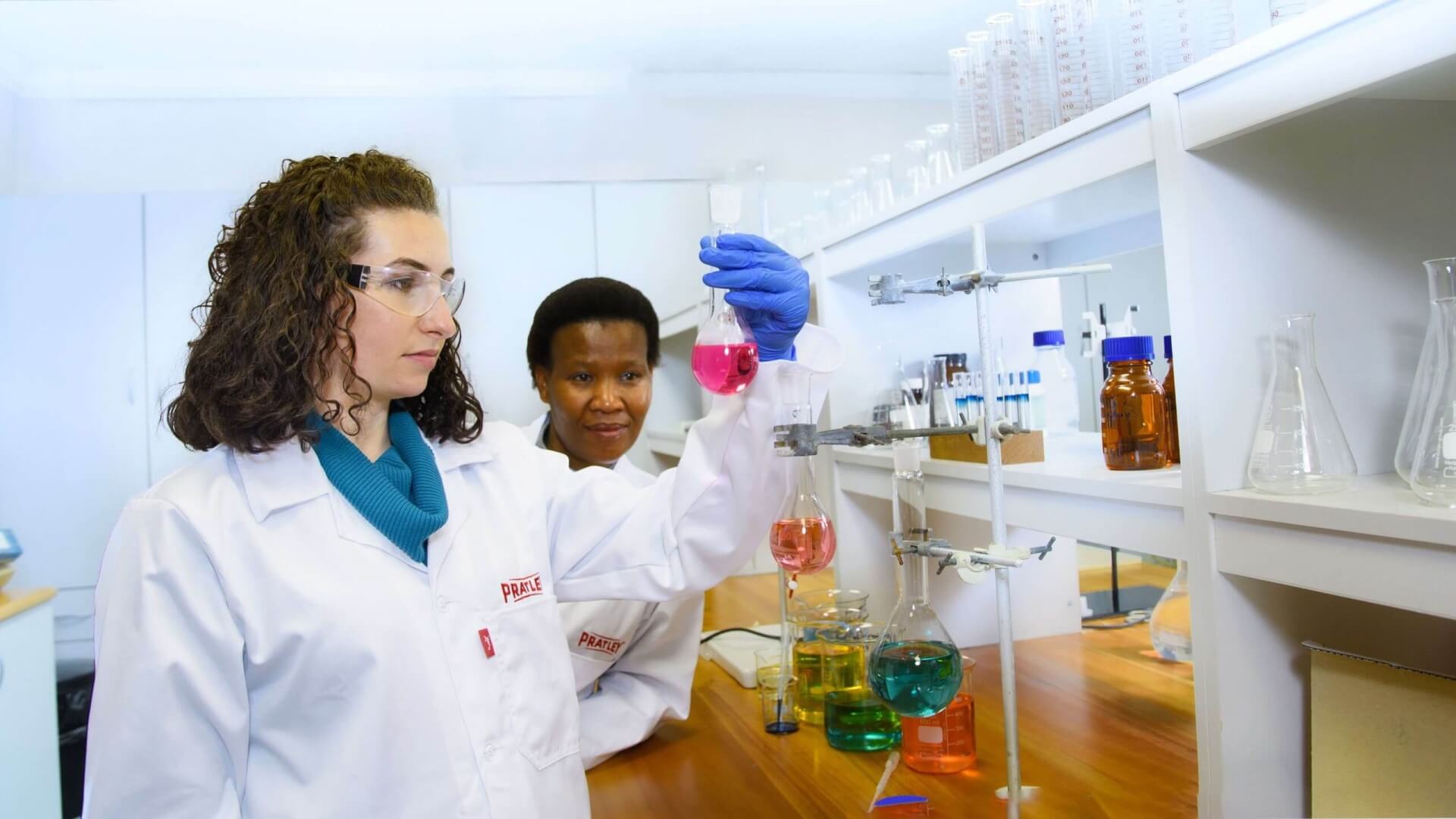



















 The founder of the Pratley, George Montague Pratley, or "Monty", was born in Johannesburg on 19 September 1917 and educated at King Edward School and Wits University. After the death of his father, he used a small inheritance to study at Rugby College of Technology and Arts in England.
The founder of the Pratley, George Montague Pratley, or "Monty", was born in Johannesburg on 19 September 1917 and educated at King Edward School and Wits University. After the death of his father, he used a small inheritance to study at Rugby College of Technology and Arts in England.

 Pratley Putty was the first of its type in the world and had the distinction of being used on one of the American space modules to land on the moon. Pratley Putty was also used in a repair of the Golden Gate Bridge spanning the San Francisco Bay, and in South Africa the holes in two sunken ships were repaired with the adhesive, which sets under water. Both ships were raised and ultimately sailed the high seas once more.
Pratley Putty was the first of its type in the world and had the distinction of being used on one of the American space modules to land on the moon. Pratley Putty was also used in a repair of the Golden Gate Bridge spanning the San Francisco Bay, and in South Africa the holes in two sunken ships were repaired with the adhesive, which sets under water. Both ships were raised and ultimately sailed the high seas once more.
